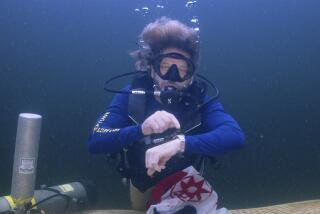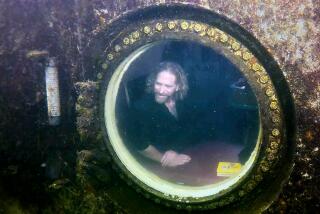Dr. Guinea Pig: Scientists as Self-Experimenters
- Share via
We hope your appetite was merely whetted last week by stories of scientists who’ve experimented on themselves. Here’s more.
After reading the book “Who Goes First?” by Lawrence K. Altman (University of California Press, 1998), we’ve learned that scientists who acted as their own guinea pigs were not exactly rare in the past. During WWII, one Danish drug company used to have a whole group of pharmacologists and technicians who routinely tried out the company’s new drugs. They called themselves the Death Battalion, and at their annual dinner-dance, the volunteer who’d engaged in the most self-experimentation was awarded a small plastic skeleton. (The Death Battalion was disbanded in 1970.)
One of the drugs thus tested was disulfiram, a possible treatment for intestinal worms. Rabbits ate disulfiram and remained perfectly content. So scientists Eric Jacobsen and Jens Hald swallowed some themselves.
All went well until one lunchtime when Jacobsen decided to quaff a beer with his sandwich--and came down with a fearsome headache and nausea. This strange event happened again and again, but only when Jacobsen or Hald drank alcohol. More experiments followed, including one in which Jacobsen became seriously ill after combining disulfiram with large doses of alcohol injected right into his bloodstream. Jacobsen eventually named the drug Antabuse: It’s used today to help people recovering from alcoholism stay away from drink.
Laughing gas, ether, hemlock, caustic acids, infected blood, untested vaccines, nasty parasites--the list of things scientists have tried on themselves goes on and on. In the 1940s, a Utah doctor, Scott Smith, wanted to know if curare, a new drug being used during surgery, really deadened pain and rendered one unconscious as well as relaxed the body’s muscles. So he arranged for his staff to slowly paralyze his body, then prick him with pins. Smith would let people know how he was doing by wiggles of fingers or blinks of his eyes.
Smith discovered that he remained totally conscious with curare and that the jabs with pins were painful--as was having his skin twisted with clamps. Smith’s wife was furious when she found out what he’d done, but at least Smith could now recommend that curare not be given alone when a patient went under the knife.
To learn more, we spoke with Trevor Norton, author of another book featuring self-experimenters, “Stars Beneath the Sea” (Carroll & Graf, 2000).
Norton, professor of marine biology at the University of Liverpool and director of its marine lab, says he’s especially fond of the pioneers of diving. As he researched their lives, he says, “I absolutely fell in love with them. They were the most eccentric, brilliant and brave people--and absolutely bonkers. Most of them experimented on themselves.”
Cameron Wright, for instance, would dangle underwater while explosives were set off closer and closer to him (so he could see how the human body responded). After a miscalculation put him in the hospital, he went back down to do the experiment again.
And then there were the Haldanes, father and son. In the late 1800s, John Scott Haldane (the older one) had an airtight chamber in the attic where he would inhale carbon dioxide and take blood samples; his daughter had instructions on how to open it should he pass out.
Father and Haldane the younger (J.B.S. Haldane) inhaled poison gases together during WWI. And Haldane the younger experimented extensively in a pressurized chamber of his own to learn how the body reacts to changes in pressure during diving.
“Almost every experiment ended with someone having a seizure, bleeding or vomiting,” Norton writes. “Nosebleeds were so common that a colleague claimed he could usually track down Haldane by following the trail of bloody handkerchiefs.”
One time, Haldane decompressed his chamber--and the air in a cavity of his tooth came screaming out until the tooth finally exploded. Haldane also permanently damaged his left buttock and burst both his eardrums during his long career.
“But he could blow smoke rings through both ears--which he thought was more than ample compensation,” says Norton. “He did it a lot at parties.”
*
If you have an idea for a Booster Shots topic, write or e-mail Rosie Mestel at the Los Angeles Times, 202 W. 1st. St., Los Angeles, CA 90012, rosie.mestel@latimes.com.






